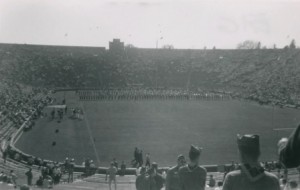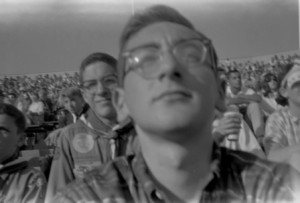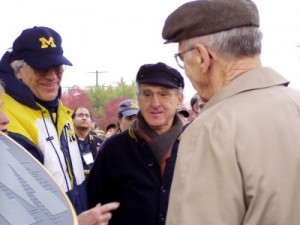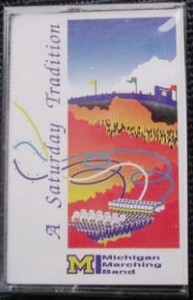The Ground Was Shaking
Theme Songs Page | Previous Theme Song | Next Theme Song
The Ground Was Shaking
Temptation, Music by Nacio Herbert Brown (1933), Arranged by Jerry Bilik (ca. 1962?), Performed by the University of Michigan Marching Band, First Encountered 1962?
It’s amazing how, when you look back on your youth, certain events seem to have been constantly repeated, yet if you possess the means of counting, you’ll see that they were actually infrequent and relatively few in number. There are things can make outsized impressions in one’s memory.
One sterling example of this for me was University of Michigan football games. Of course, growing up in Ann Arbor, Michigan, I experienced football as a secular religion that no church could ever compete with. The town pretty much stopped doing business on home game Saturdays. Most Ann Arborites were at the game: the Stadium had about as many seats as the town had people. Even a relatively unathletic and un-sports-struck young man like myself stood no chance of standing aside from the spectacle. And in those days, it was possible for youngsters to get up front and personal with Michigan football even without the aid of a rich parent.[1] In fact with a high school ID, I could get into end zone seats for a dollar, if the game didn’t sell out.
And in my memory, as I was saying, it seems as if I was going all the time, at least in my high school years. My mom’s diary says otherwise. It reflects that I went once in first grade, and 18 times in junior high and high school. Now that’s not negligible, but it’s not constant. About one percent of the days in my high school years. And yet the memory is golden and large for me. It feels like a constant and frequent thing.
I think the discrepancy between what I feel and what I know is to be explained by a number of things, not least that even if I wasn’t there at the game because it was away or sold out, I was still listening to it and living it along with everyone else in town. (Even my parents, who affected far more lack of interest and scorn for this distinctly unintellectual pursuit than they actually felt.)
Games actually experienced in person were cathartic. You entered what they now call The Big House by climbing a hill, walking under stands that towered over you, and then the world would suddenly open up, as the field was well below the outside grade, and you were suspended in this huge bowl halfway between earth and sky. And that was the environment in which you’d start to experience all the wonderful things U.S. football culture does to heighten the experience, including the cheerleaders (then an all-male gymnastic corps, very natty in Michigan maize sweaters), the crowd, awash in the colors of the University and its rivals, the booming amplified voice of the announcers, and the game itself. And you’d be there with friends, and/or sometimes a date, and the sharing of the experience would add a whole other dimension.
And, then, of course, there was the marching band.
 That band was almost as much a religious idol as the team itself. There’s an excellent Wikipedia article that explains better than I can the folkways an
That band was almost as much a religious idol as the team itself. There’s an excellent Wikipedia article that explains better than I can the folkways an d traditions of the band around and during the games. Suffice it to say that you heard the music long before the band or you entered the Stadium, and for a while after the game as well. The band would warm up in the morning elsewhere around the campus and march into the Stadium in the run-up to the game. If you lived anywhere around the heart of town, you’d hear them echoing through the streets. And they’d fill the field after the game and play some more.
d traditions of the band around and during the games. Suffice it to say that you heard the music long before the band or you entered the Stadium, and for a while after the game as well. The band would warm up in the morning elsewhere around the campus and march into the Stadium in the run-up to the game. If you lived anywhere around the heart of town, you’d hear them echoing through the streets. And they’d fill the field after the game and play some more.
That’s the part I want to write about. That’s the part where I could exit the stands and swarm on out to the field myself. Understand that it can get pretty cold in the stands, no matter how enthusiastic you might be and however much time you might have spent on your feet. The sun might be sinking lower in the sky at that point; 3:30 p.m. on a late fall day can be distinctly tinged with dusk, particularly if it’s overcast. The glorious disorientation you might have felt upon emerging into the Stadium three hours earlier will have worn off, and you have been focusing on a patch of grass for most of those hours, but needless to say you have been kept from coming near that beautifully tended and inviting-looking by ushers and cops.[2]
And then suddenly, the constraints begin to come off just as the tension of the game, for better or for worse, falls away. In the last few minutes, the marching band begins to file back onto the sidelines. And as the game actually ends, the band occupies the field and starts to play. The police officers who had blocked fan access to the field stand aside, and we fans who want the flavor to last for a few more minutes can relieve the psychic tension and go down there, onto that legendary parch of grass, and stand almost amidst the band.
There are various musical experiences that are so intense nothing else, certainly nothing recorded, can duplicate them. And one of them is being in the midst of a top-notch marching band in full voice.
The Band will certainly play the Jerry Bilik arrangement of Temptation,[3] which has a thunderous but dexterous drum line that rapidly hands the timekeeping and embellishment back and forth among a variety of timpani. You can stand right there a couple of feet from the bass drummers, as they shake the earth, unpredictably contributing to an overall boom-ba-ba-ba-boom-ba-ba-ba-boom-ba-ba-ba-boom in time to the song, and it is a form of aural ecstasy.
You are at the center of the universe, in a place filled with the power of blaring tubas and resounding drums. If, like me then and now, you believe in theme songs, then this for the moment is yours, a rousing challenge to the universe.
You think I’m exaggerating? There’s a modern video that captures the musical power of the number, though it’s a grainy rendering (and I notice they don’t allow fans on the field any more). This one’s not bad either though also grainy, and in this instance shot away from the Stadium. (I think these modern versions may have a few more trick moves by the guys with the cymbals, but otherwise they look and sound the same as what I recall.)
So where did all this percussive power come from? To start with, never underestimate the power of a good arranger. Bilik was wonderful. He completed the redesign of the song from a crooner ballad to a power number. The process seems to have taken about thirty years. Wikipedia says that it was published in 1933 by Nacio Herbert Brown (music) and Arthur Freed (lyrics). Freed at least was a big name, the king of the early MGM musicals. And indeed the song appeared first in an MGM musical, Going Hollywood, with Bing Crosby and Marion Davies, in that year. Crosby also recorded it that year with Len Hayton’s orchestra, an exercise in pure crooning. Others who gave it that treatment were Perry Como, who tangoed it up in 1945,[4] and Mario Lanza, who did the same in 1952. The tango element was played up even more in a version played in the movie Singin’ in the Rain (1952), where it was actually called Temptation (Tango). But the man who truly taught the song to swing was bandleader Artie Shaw around 1940. In the syncopated tom-toms that propel his version, you can hear the beat that must have set Jerry Bilik’s imagination wandering.
Not that Bilik merely transcribed Shaw’s version for the marching band, not at all. Shaw’s version is still a dance n umber, although the dancing would have had to have been pretty energetic (GIs just going away to war when the Shaw version came out would have been motivated to toss their sweethearts around with abandon, no doubt). Bilik, a Michigan man himself, and shown in the middle of the group from the 2002 Homecoming at the right, took this slightly antique-sounding piece of pre-war pop (published the year Bilik was born),[5] swapped the tango rhythm for a bolero rhythm, took out the croony bridge and threw in something that Khatchaturian would have used for a Dervish dance, and turned the thing into a bellow of athletic power, causing the earth to tremble and the ears to tingle with the heavy use of cymbals. In his hands, it’s nobody’s love song; it’s something much more brilliant and dynamic, but also more primitive. It’s a hymn to the football war god.
umber, although the dancing would have had to have been pretty energetic (GIs just going away to war when the Shaw version came out would have been motivated to toss their sweethearts around with abandon, no doubt). Bilik, a Michigan man himself, and shown in the middle of the group from the 2002 Homecoming at the right, took this slightly antique-sounding piece of pre-war pop (published the year Bilik was born),[5] swapped the tango rhythm for a bolero rhythm, took out the croony bridge and threw in something that Khatchaturian would have used for a Dervish dance, and turned the thing into a bellow of athletic power, causing the earth to tremble and the ears to tingle with the heavy use of cymbals. In his hands, it’s nobody’s love song; it’s something much more brilliant and dynamic, but also more primitive. It’s a hymn to the football war god.
The previously-mentioned Wikipedia article on the Marching Band itself, accessed in 2010, says that the band’s post-game routine with Temptation goes back around forty years. I’m here to say that as of 2010 it was more like 50. The song was a constant at least by my early game-attending years.
And when I think back to the whole Michigan football experience of my youth, I always start with a vivid picture of myself, standing on that field under a darkening, cold sky, being consoled for a team loss (and maybe misfortunes in my own young life at the time) by the indomitable sound of those drums and tympani shaking the earth. Mischance is being defied. For a moment at least, Michigan, and I as one of its fans, are transcendent. The universe is ours.
Go Blue!
Note: Source for the Jerry Bilik picture: http://www.umbaa.org/about/pictures.html
[1]. Today, even season end zone tickets seem to require a personal seat license fee (the official website coyly calls it a “donation”) of $50, on top of the seat price, which exceeds $50. (If I’m reading it right.)
[2]. Once, with some friends, I snuck into the Stadium when there was no one there, and we played a game of touch football for a while on that legendary surface. Only once, though. My guess is that couldn’t happen since 9/11.
[3]. Not downloadable from anywhere, so far as I can see. You can buy it at Amazon as part of a CD, the cassette version of which is copied above.
[4]. I think the version hyperlinked is the one referenced, but I understand that it might be a 1974 remake.
[5]. He is reportedly now the Creative Director for Disney on Ice.
Copyright (c) Jack L. B. Gohn, except for album art
Theme Songs Page | Previous Theme Song | Next Theme Song
